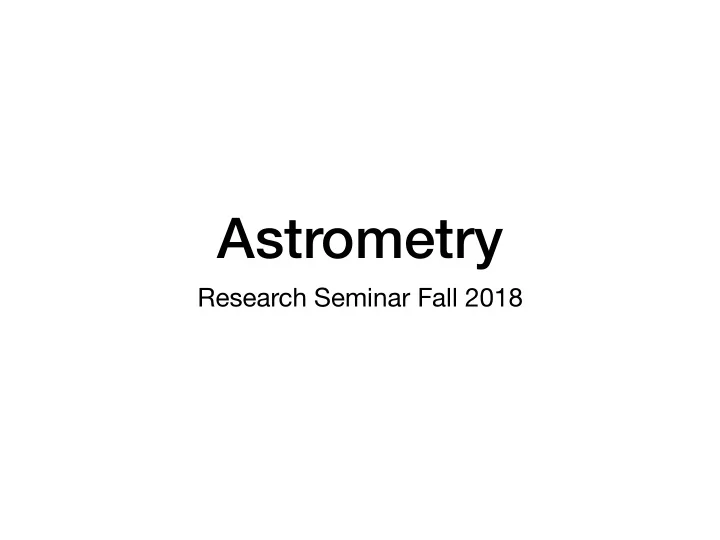

Astrometry Research Seminar Fall 2018
Ground-based Astrometry Carlsberg Meridian circle / transit telescope 0.03’’ - 0.05’’ Meridian • Single positional dof, usually oriented along Telescope meridian first light: 1984 • Use time of star’s crossing to measure RA • CMT used in conjunction with Hipparcos Astrolabe / zenith tubes • Use mercury to accurately determine zenith position • Reflected/nonreflected light meet when star is at given latitude (here 60 degrees)
( Hi gh P recision Par allax Co llecting S atellite) • November 1989 to March 1993 (Hipparchos) • Supposed to be geostationary, but stuck on transfer orbit Produced a catalog of 1080 stars, each labelled “bright” or “small”
Hipparcos Gaia Magnitude limit 12 mag 20 mag Completeness 7.3 – 9.0 mag 20 mag Bright limit 0 mag 3 mag (assessment for brighter stars ongoing) Number of objects 120,000 47 million to G = 15 mag 360 million to G = 18 mag 1192 million to G = 20 mag Effective distance limit 1 kpc 50 kpc Quasars 1 (3C 273) 500,000 Galaxies None 1,000,000 Accuracy 1 milliarcsec 7 µ arcsec at G = 10 mag 26 µ arcsec at G = 15 mag 600 µ arcsec at G = 20 mag Photometry 2-colour (B and V) Low-res. spectra to G = 20 mag Radial velocity None 15 km s -1 to G RVS = 16 mag Observing Pre-selected Complete and unbiased
Tension between parallactic precision and solar radiation Must be wide, can’t be harmonic of 360
Successive observations yield proper motion / parallax Scan width = 0.7° � 9 1. Object matching in successive scans 2. Attitude and calibrations are updated 3. Objects positions etc. are solved Sky scans 4. Higher-order terms are solved (highest accuracy 5. More scans are added 6. System is iterated along scan) Figure courtesy Michael Perryman
~70 transits per target over 5 years
https://www.cosmos.esa.int/web/gaia/focal-plane
Photometric Instrument • Goal: Te ff for all targets • BP: 330–680 nm • RP: 640–1050 nm • Objects are selected for RV instrument by RP very low resolution
Spectroscopic Instrument • Goal: radial velocity for stars down to 17th mag, abundances, reddening • Near-infrared (845–872 nm) • Medium resolution ( λ / Δλ ~ 11500) • Will observe 100-150 million stars ~40 times each Early Late X-ray transient Bandpass Grating
DR3 (targeting 2021): improved astrometry, object classification, spectra released, solar-system catalog
Recommend
More recommend